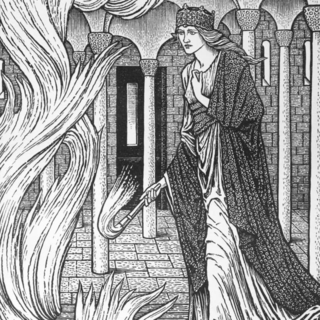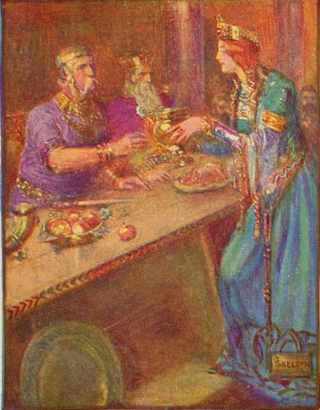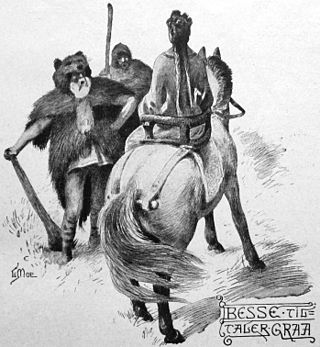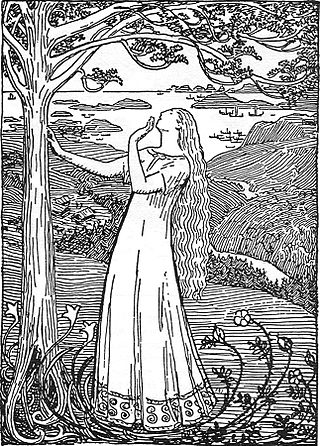Related Research Articles

Edward the Confessor was an Anglo-Saxon English king and saint. Usually considered the last king of the House of Wessex, he ruled from 1042 until his death in 1066.

Harthacnut, traditionally Hardicanute, sometimes referred to as Canute III, was King of Denmark from 1035 to 1042 and King of England from 1040 to 1042.

Harold I, also known as Harold Harefoot, was regent of England from 1035 to 1037 and King of the English from 1037 to 1040. Harold's nickname "Harefoot" is first recorded as "Harefoh" or "Harefah" in the twelfth century in the history of Ely Abbey, and according to some late medieval chroniclers it meant that he was "fleet of foot".

Gudrun or Kriemhild is the wife of Sigurd/Siegfried and a major figure in Germanic heroic legend and literature. She is believed to have her origins in Ildico, last wife of Attila the Hun, and two queens of the Merovingian dynasty, Brunhilda of Austrasia and Fredegund.

Hrólfr Kraki, Hroðulf, Rolfo, Roluo, Rolf Krage was a semi-legendary Danish king who appears in both Anglo-Saxon and Scandinavian tradition.

Hrothgar was a semi-legendary Danish king living around the early sixth century AD. Many years later, Hrothgar paid money to the Wulfings to resolve a blood feud they had with Ecgtheow, Beowulf's father.

Eric IV, also known as Eric Ploughpenny or Eric Plowpenny, was King of Denmark from 1241 until his death in 1250. His reign was marked by conflict and civil wars against his brothers.

In Norse mythology, Gróa is a völva (seeress) and practitioner of seiðr. She is the wife of Aurvandil the Bold. Groa was also the goddess of knowledge.

Halga, Helgi, Helghe or Helgo was a legendary Danish king living in the early 6th century. His name would in his own language (Proto-Norse) have been *Hailaga.

Gundaharius or Gundahar, better known by his legendary names Gunther or Gunnar, was a historical king of Burgundy in the early 5th century. Gundahar is attested as ruling his people shortly after they crossed the Rhine into Roman Gaul. He was involved in the campaigns of the failed Roman usurper Jovinus before the latter's defeat, after which he was settled on the left bank of the Rhine as a Roman ally. In 436, Gundahar launched an attack from his kingdom on the Roman province of Belgica Prima. He was defeated by the Roman general Flavius Aetius, who destroyed Gundahar's kingdom with the help of Hunnish mercenaries the following year, resulting in Gundahar's death.

Sigurd Snake-in-the-Eye or Sigurd Ragnarsson was a semi-legendary Viking warrior and Danish king active from the mid to late 9th century. According to multiple saga sources and Scandinavian histories from the 12th century and later, he is one of the sons of the legendary Viking Ragnar Lodbrok and Áslaug. His historical prototype might have been the Danish King Sigfred who ruled briefly in the 870s. Norwegian kings' genealogies of the Middle Ages name him as an ancestor of Harald Fairhair and used his mother's supposed ancestry to Völsung in order to create an ancestry between Harald and his descendants and Odin.

The term Nibelung (German) or Niflungr is a personal or clan name with several competing and contradictory uses in Germanic heroic legend. It has an unclear etymology, but is often connected to the root Nebel, meaning mist. The term in its various meanings gives its name to the Middle High German heroic epic the Nibelungenlied.

Frederick Christian II, Duke of Schleswig-Holstein-Sonderburg-Augustenburg was a Danish prince and feudal magnate. He held the island of Als and some other castles in Schleswig.
Hrólfs saga kraka, the Saga of King Rolf Kraki, is a late legendary saga on the adventures Hrólfr Kraki, a semi-legendary king in what is now Denmark, and his clan, the Skjöldungs. The events can be dated to the late 5th century and the 6th century. A precursor text may have dated to the 13th century, but the saga in the form that survived to this day dates to c. 1400. Forty-four manuscripts survive, but the oldest one of them is from the 17th century, although a manuscript is known to have existed c. 1461 at the monastery of Möðruvellir in Iceland.
Sigurd Hart or Sigurd Hjort was a legendary king of Ringerike, during the late 9th or early 10th centuries. he is mentioned in Ragnarssona þáttr and in Halvdan Svartes saga.

The name Ragnhild Sigurdsdotter may refer to two different figures from Old Norse literature, an amalgam of them, or a purely fictitious figure.

Gunnhildr konungamóðir or Gunnhildr Gormsdóttir, whose name is often Anglicised as Gunnhild, is a quasi-historical figure who appears in the Icelandic Sagas, according to which she was the wife of Eric Bloodaxe. She appears prominently in sagas such as Fagrskinna, Egils saga, Njáls saga, and Heimskringla.

Sigurd or Siegfried is a legendary hero of Germanic heroic legend, who killed a dragon—known in some Old Norse sources as Fáfnir—and who was later murdered. In both the Norse and continental Germanic tradition, Sigurd is portrayed as dying as the result of a quarrel between his wife (Gudrun/Kriemhild) and another woman, Brunhild, whom he has tricked into marrying the Burgundian king Gunnar/Gunther. His slaying of a dragon and possession of the hoard of the Nibelungen is also common to both traditions. In other respects, however, the two traditions appear to diverge. The most important works to feature Sigurd are the Nibelungenlied, the Völsunga saga, and the Poetic Edda. He also appears in numerous other works from both Germany and Scandinavia, including a series of medieval and early modern Scandinavian ballads.
Svipdagr or Swipdag was a legendary king of Norway, and later of Denmark and Sweden, and important figure in Book One of Gesta Danorum. He came into conflict with Gram of Denmark and Gram's sons.
Guthormr or Guttormr was according to traditions current in Iceland in the eleventh and twelfth centuries, a noble of Danish origin operating in Norway and the maternal uncle of Norway's first king, Harald Fairhair. By various sources he is said to have been the son of Sigurd Hart, brother of Ragnhild Sigurdsdotter and the descendant of Ragnar Lodbrok. Several sources gives him the title dux and hertỏga both meaning "duke".
References
- ↑ "The Danish History, Book One". www.sacred-texts.com.